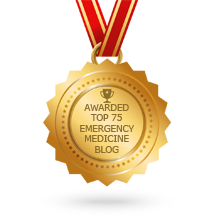The 2-hr Acetaminophen Level and Other Tall Tales from our Favorite Analgesic
/First, some Core Content
- Acetaminophen (APAP) is a very common ingestion in overdose (OD) patients.
- It is the leading cause of acute liver failure in the USA.
- Overdose patients represent a high-risk population. Therefore it is very important to assess, risk stratify, and treat when appropriate.
- An acetaminophen level is part of the “suicide panel” (acetaminophen, aspirin, basic metabolic panel, EKG)
- An APAP level represents a good screening test as it fulfills the following criteria:
It is sensitive, thereby minimizing false negatives.
Its cost is reasonable.
Early APAP OD is often asymptomatic until liver injury is evident - an elevated APAP level can diagnose it early.
A positive test will require treatment that can change the patient's outcome.
- The Rumack-Matthew nomogram plots the APAP level vs the time of ingestion to risk stratify the exposure and determine if intervention is indicated.
Do we always need to screen for apap ingestion (in suicide patients) or can we only test those that report an APAP ingestion?
- Although they are small studies, there is data to suggest that patients can have a clinically relevant ingestion despite no history of APAP ingestion.
- 0.2% had potentially toxic levels not suggested by history (Ashbourne 1989)
- 3% of patients had measurable APAP levels who were APAP history negative (Sporer 1996)
- 0.3% had potentially toxic levels not suggested by history (Sporer 1996)
- 2.2% had potentially toxic levels not suggested by history (Lucanie 2002)
- There are some other small studies that suggest otherwise, however the patient populations are somewhat different.
- It is reasonable to do one blood test in an asymptomatic patient if it has the potential to save a life (or liver).
- In high-risk patients, it is reasonable to document a negative or non-treatable level especially if they are going to be discharged (in case of return visit).
Bottom line: I recommend screening for APAP toxicity in intentional overdose patients unless there is some truly compelling reason not to do so.
Can we use an acetaminophen level less than 4hr post ingestion to risk stratify these patients?
This is a difficult question.
Although they are small studies, there is new data to suggest there are people below the treatment line prior to 4 hours who then cross the line after 4 hours:
Patients with non-toxic levels prior to 4 hours were found to have toxic levels after 4 hours (Froberg 2013).
The negative predictive value (for non-toxic 4 hour levels) was 76% for APAP concentrations drawn within 1 hour and 99% between 3-4 hrs (Douglas 1994, abstract).
- A recent study (Yarema 2016) suggested that (due to rapid APAP absorption) a zero APAP concentration obtained 1-4 hours after ingestion may not require further APAP testing. Although this was a reasonably well done study, I think this recommendation needs to be utilized carefully. It’s unclear what the effect anti-muscarinics or opioids may have on APAP absorption. There has also been some concern that this time frame may not be sensitive enough nor the negative predicative value good enough to obviate the need for a 4 hour level (Spyres 2017). In a situation in which we can save a life or a liver, the negative predictive value of less than 4 hour may not be good enough to mitigate the risk.
Bottom line: Based on the appropriate use of the Rumack Mathew Nomogram, we continue to recommend at least a 4 hour APAP level. However, I think if at least a 3 hour level is undetectable, we likely don’t need to repeat it if we are sure of a time of ingestion.
If I don’t have a time of ingestion, can I just get a second level and if it's going down, assume they are non-toxic?
- No …. a level is just a level without a time of ingestion. The level is only useful when plotted against a time of ingestion.
- Let's take the level of 100 ug/ml as an example:
- It is non-toxic as a 4 hour level but toxic if it is an 8 hour level. Letting it drop to 78 ug/ml after a few hours doesn’t tell you anything.
- The same 78 ug/ml on the same patient is non-toxic as an 8 hour level but toxic as a 12 hour level.
- If there is absolutely no way to get close to a time of ingestion (remember, we know how far out a level would be for toxicity ….get close) the poison center can help you risk stratify.
Bottom line: You cannot use a falling level to obviate the need for treatment of acetaminophen toxicity. The same level can be toxic or non-toxic depending on the time of ingestion. This is not an appropriate way to risk stratify an ingestion.
Why do we give N-ACetylcysteine (NAC) if the APAP level is undetectable? Is there still efficacy?
- NAC has multiple mechanisms of action which are leveraged depending on whether a person is an early-presenter (and has detectable APAP level) or is someone with hepatic injury/failure without a detectable level.
- Mechanism of action:
- In acetaminophen toxicity with detectable level you are treating to detoxify the toxin:
- NAC enhances glutathione stores
- NAC acts as a glutathione surrogate
- NAC shunts metabolism towards sulfation
- NAC directly detoxifies NAPQI
- In acetaminophen toxicity with detectable level you are treating to detoxify the toxin:
- If NAC is given within 8-10 hours of an acute ingestion, there is < 5% probability of fulminant hepatotoxicity.
- There is no improvement in outcome if given between 0-4 hours versus 4-8 hours (so don’t give NAC unless you have a confirmed indication)
- If after 10 hours, the risk of hepatotoxicity increases (risk/benefit begins to change)
- If NAC is given to a patient in fulminant hepatic failure from acetaminophen toxicity, mortality is improved.
- In acetaminophen toxicity without a detectable level (hepatic injury or failure) NAC is helping to heal the liver.
- NAC reduces the effect of toxic oxidative free radicals (the mechanism that may propagate injury).
- NAC enhances vasodilatory effect of nitric oxide improving hemodynamics and oxygen transport
Bottom line: Think of NAC as two different medications depending on why you are using it (early presenters vs those with hepatic injury and an undetectable APAP level). Depending on the situation there is efficacy to the use of NAC whether there is a detectable level or not.
Tired of reading? watch Dr. Schaeffer discuss the ins and outs of acetaminophen toxicity
Tammi H. Schaeffer, DO, FACEP, FACMT
Associate Professor of Emergency Medicine, Tufts University School of Medicine, Boston, MA
Medical Director Northern New England Poison Center, Portland, ME
Attending Physician, Department of Emergency Medicine, Maine Medical Center, Portland, ME
Edited and Posted by Jeffrey A. Holmes, MD
References
1. Harrison PM, Keays R, Bray GP, et al. Improved outcome of paracetamol- induced fulminant hepatic failure by late administration of acetylcysteine. Lancet 1990;335(8705):1572–3.
2. Keays R, Harrison PM, Wendon JA, et al. Intravenous acetylcysteine in parace- tamol induced fulminant hepatic failure: a prospective controlled trial. BMJ 1991;303(6809):1026–9.
3. Harrison PM, Wendon JA, Gimson AE, et al. Improvement by acetylcysteine of hemodynamics and oxygen transport in fulminant hepatic failure. N Engl J Med 1991;324(26):1852–7.
4. Heard K, Rumack BH, Green JL, Bucher-Bartelson B, Heard S, Bronstein AC, Dart RC. A single-arm clinical trial of a 48-hour intravenous N-acetylcysteine protocol for treatment of acetaminophen poisoning.Clin Toxicol (Phila). 2014 Jun;52(5):512-8. Epub 2014 Apr 8.
5. Rumack BH, Peterson RC, Koch GG, Amara IA. Acetaminophen overdose. 662 cases with evaluation of oral acetylcysteine treatment. Arch Intern Med. 1981;141(3 Spec No):380.
6. Prescott LF. Treatment of severe acetaminophen poisoning with intravenous acetylcysteine. Arch Intern Med. 1981;141(3 Spec No):386.
7. Smilkstein MJ, Knapp GL, Kulig KW, Rumack BH. Efficacy of oral N-acetylcysteine in the treatment of acetaminophen overdose. Analysis of the national multicenter study (1976 to 1985) N Engl J Med. 1988;319(24):1557.
8. Dambach DM, Durham SK, Laskin JD, Laskin DL: Distinct roles of NF-kappaB p50 in the regulation of acetaminophen-induced inflammatory mediator production and hepatotoxicity. Toxicol Appl Pharmacol 2006, 211: 157–165.
9. Adamson GM, Harman AW: Oxidative stress in cultured hepatocytes exposed to acetaminophen. Biochem Pharmacol 1993, 45: 2289–2294.
10. Jones AL: Mechanism of action and value of N -acetylcysteine in the treatment of early and late acetaminophen poisoning: a critical review. J Toxicol Clin Toxicol 1998, 36: 277–285.
11. Braughler JM. Sulfhydryl group involvement in the modulation of guanosine 3’, 5’-monophosphate metabolism by nitric oxide norepinephrine, pyruvate and t-butyl hydroperoxide in minced rat lung. Biochem Pharmacol 1982; 31: 3847.
12. Stamler J, Mendelsohn ME, Amarante P. N-acetylcysteine potentiates platelet inhibition by endothelium- derived relaxing factor. Circ Res 1989; 65: 789.
13. Siriussawakul A, Zaky A, Lang JD. Role of nitric oxide in hepatic ischemia-reperfusion injury. World J Gastroenterol 2010; 16: 6079-86.
14. Yarema MC, Green JP, Sivilotti ML, Johnson DW, Nettel-Aguirre A, Victorino, C, Spyker DA & Rumack BH(2017) Can a serum acetaminophen concentration obtained less than 4 hours post-ingestion determine which patients do not require treatment with acetylcysteine?, Clinical Toxicology, 55:2, 102-108, 2016
15. Spyres MB, O’Connor AD & Gerkin, RDD (2017): Limitations of the evidence supporting use of undetectable acetaminophen levels obtained <4 hours post- ingestion to rule out toxicity, Clinical Toxicology,














